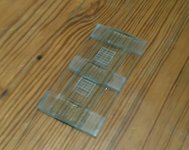A couple of years ago, a student asked on here for poo samples to help with a project on chicken worms, and she subsequently sent me a report on the samples I supplied. I was able to send a separate sample from each of my hens as I had looked in the coop after dark and mapped out where each was perching, so then I could get a sample from a 'named' pile. At the time, the hens had last been wormed about 4 months previously, so some worms might have been expected but not too many. Actually the only bird who had any worms was Marigold, who had a few, all one type, can't remember which. I thought it was interesting that she should have developed the worms when the others apparently were immune.
I do wonder whether a deep litter, roofed run with no access to wild birds really helps prevent worm infestation, not only because the hens don't get to eat any earthworms or peck around in soil, but because they don't get wild bird droppings in the litter. And of course, the roof must be the reason why I've never encountered red mite either, as even if wild birds perch on the roof and shake their feathers, no mites can get in to the run or coop. Yes, free ranging on grass is lovely if you have enough space and proper grass, but they seem to do just as well in a large enough run, kept clean, and given grass or fresh greens every day.

